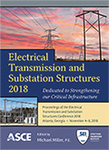Electrical Transmission and Substation Structures 2018
Question: What Is an Acceptable Target Reliability for High-Voltage Transmission Lines?
Publication: Electrical Transmission and Substation Structures 2018: Dedicated to Strengthening our Critical Infrastructure
ABSTRACT
With the national interest in critical lifeline infrastructure system performance and resiliency it may be time for the high-voltage transmission line industry to consider the current reliability level of an electric transmission line system. ASCE 7-10 and 7-16 standards have introduced target reliabilities for buildings and other structures. The question maybe asked, in the near future, what is the current design reliability level of a high-voltage electric transmission line and how does it compare with ASCE 7 target reliabilities? Probability/reliability based design (P/RBD) of transmission lines is not new to transmission line designers. In the 1980s, and into the 1990s, probability based design was being investigated for application to transmission lines. A significant number of studies were completed to better understand the reliability provided by transmission line structural design practice. Also, there is data collected on transmission line failures, and full-scale tower test results that can be used to consider the question of current reliability levels. Based on available information, are existing levels of design reliability acceptable and if not where should the industry target transmission lines for performance base design concepts? This paper will introduce the question, what is the acceptable target reliability for a transmission line, to current and next generation of transmission line engineers.
Get full access to this article
View all available purchase options and get full access to this chapter.
REFERENCE
ASCE-7 (2010). Minimum Design Loads for Buildings and Other Structures, American Society of Civil Engineers, Resto, VA.
ASCE-7 (2016). Minimum Design Loads for Buildings and Other Structures, American Society of Civil Engineers, Resto, VA.
ASCE-74 (1984). Guidelines for electrical transmission line structural loading, First edition, ASCE manual No. 74, American Society of Civil Engineers, New York, NY.
ASCE-74 (1991). Guidelines for electrical transmission line structural loading, Second editionASCE manual No. 74, American Society of Civil Engineers, New York, NY.
ASCE-74 (2015). Guidelines for electrical transmission line structural loading, Third editionASCE manual No. 74, American Society of Civil Engineers, New York, NY.
ASCE-10 (2015). Design of Lattice Steel Transmission Structures, ASCE Standard 10, American Society of Civil Engineers, New York, NY.
ASCE-48 (2016). Design of Steel Transmission Pole Structures, ASCE Standard 48, American Society of Civil Engineers, New York, NY.
Bruneau, M. and Reinhorn, A., (2006). Overview of the Resilience Concept, Proceedings of the 8thU.S. National Conference on Earthquake Engineering, San Francisco, CA.
Correspondence (2005). Tower Failures, 2005
Ferreira Da Silva, J. B. G and Cadete M. A. M.1990. Tests on transmission Tower Prototypes Evaluation of Results and Failure, Meddes Junior Industrial LTDA, Brazil, CIGRE WG 08 / Study Group 22, Paris, France.
Digioia, A. M. and Jackman, D. E. (1983). Why Use Probabilistic Methods in designing Transmission line, IEEE PES Summer meeting, Institute of Electrical and Electronic Engineers, New York, NY.
IEC (2003). Design Criteria of Overhead Transmission Lines, IEC Standard 60826, International Electrotechnical Commission, Geneva, Switzerland.
IEEE (2012). Guide for Electric Power Distribution Reliability Indices, Institute of Electrical and Electronic Engineers, IEEE Standard 1366, New York, NY.
NAP (2017). Enhancing the Resilience of the Nation’s Electricity System, The National Academies of Sciences, Engineering, and Medicine, (http://www.nap.edu/24836) WA, DC
NESC (2017). National Electrical Safety Code, Institute of Electrical and Electronic Engineers, Inc., New York, NY.
NESC (2017). Grid Resilience and the NESC, IEEE Standards Association, Institute of Electrical and Electronic Engineers, Inc., New York, NY.
NIAC (2010). A framework for Establishing Critical Infrastructure Resilience Goals; Final Report and Recommendations, National Infrastructure Advisory Council, Homeland Security. Washington, DC.
NIST (2010). Disaster Resilience: A Guide to Literature, Special Publication 1117, National Institute of Standards and Technology, Gaithersburg, MD.
NIST (2015). Community Resilience Planning Guide for Buildings and Infrastructure, Volumes 1 & 2, Special Publication 1190, National Institute of Standards and Technology, Gaithersburg, MD.
NIST (2016). Guide Brief 5 - Assessing Energy System Dependencies, Special Publication 1190GB-5, National Institute of Standards and Technology, Gaithersburg, MD.
OSSPAC (2013). Reducing Risk and Improving Recovery for the Next Cascadia Earthquake and Tsunami, The Oregon Resilience Plan, Oregon Seismic Safety Policy Advisory Commission (OSSPAC), Salem, OR.
Paschen, R., Pezard, J., and Zago, P. (1988), Probabilistic Evaluation on test Results of transmission Line Towers, CIGRE paper 22-13, Paris, France
RAND (2015). Measuring the Resiliency of Energy Distribution Systems, Willis, H.H. & Loa, K., Rand Corporation, Santa Monica, CA.
TDWorld (2017), What does Resiliency Actually Mean, http://tdworld.com/grill-grid-master/what-does-resiliency-actually-mean)
Information & Authors
Information
Published In
Electrical Transmission and Substation Structures 2018: Dedicated to Strengthening our Critical Infrastructure
Pages: 281 - 289
Editor: Michael Miller, SAE Towers
ISBN (Online): 978-0-7844-8183-7
Copyright
© 2018 American Society of Civil Engineers.
History
Published online: Nov 1, 2018
Published in print: Nov 1, 2018
Authors
Metrics & Citations
Metrics
Citations
Download citation
If you have the appropriate software installed, you can download article citation data to the citation manager of your choice. Simply select your manager software from the list below and click Download.
